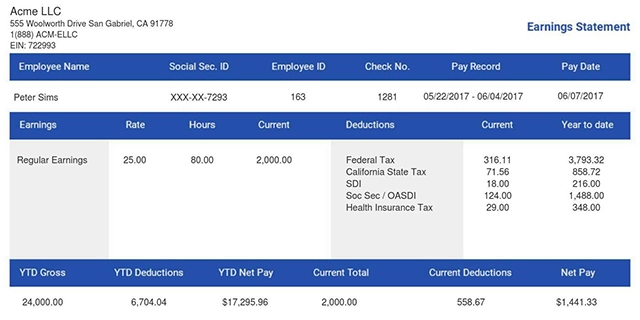Everything You Should Know about the Pay Period
The first step to proper financial management is knowing when and how often you get paid. You may be starting a new job or running your own business.
In any case, it is important to have a basic grasp of your pay period. This is important for planning your financials and payroll management.
This detailed breakdown goes through everything you need to know about pay periods. From basics to what it means for employers and employees.
What Is a Pay Period?
A pay period is a recurring schedule an employer uses to track employee work time and compute compensation. Picture it as a consistent time block and that time block shows when you earn your pay and receive it. When it comes to compensation, this period is the foundation of the employer-employee relationship.
From overtime calculation to tax withholdings, pay periods affect everything. This makes them an important part of payroll management. It helps employees to budget and plan their financials properly. It also helps in maintaining accurate records and paying compensation on time for employers.
What are the Pay Period Key Elements?
These include:
-
Start and end dates
-
Payment dates
-
Hours worked tracking
-
Overtime calculations
-
Tax withholding periods
-
Benefits deduction timing
How Long Is a Pay Period?
There are different types, with varying numbers of days and weeks. Let’s take a look at the different types of pay periods:
-
Weekly Pay Period
As you can guess, a weekly pay period means that employees get paid weekly, on the same day each week. Thus, they get 52 paychecks per year. That's especially true of industries such as retail, construction, and the food service industry, where the norm is hourly wage.
This weekly type offers constant, regular cash in employees' hands. This makes budgeting easier for many, especially for those who live paycheck to paycheck. But for employers, it does mean that they’ll have to process payroll 52 times a year. This makes it more time-consuming and expensive than other options.
-
Bi-weekly Pay Period
Bi-weekly pay periods are by far the most popular in the United States and represent paying employees once every two weeks. This amounts to getting a paycheck 26 times annually. This schedule has an interesting quirk. Twice a year, employees receive three paychecks in one month, and this is known as 'three-paycheck months.'
A balance between employee satisfaction and employer efficiency is achieved by bi-weekly pay. This approach facilitates relatively frequent paychecks for workers. The administrative burden is also lowered unlike with weekly processing. A lot of employees enjoy the predictability of knowing they’ll get paid every other Friday, minding their books better.
-
Semi-monthly Pay Period
The semi-monthly one typically lines up with the calendar and the 2024 pay period calendar is no exception. Employees get 24 paychecks per year. They are paid once on the 1st and 15th or 15th and last day of the month. Lots of salaried employees find this schedule to be appealing as it fits with their monthly bills and expenses.
Yet, following a semi-monthly pay cycle makes it difficult to process overtime. It also makes it challenging to deal with hourly employees who don’t have a regular work week. However, despite these challenges, the majority of these organizations often prefer this schedule. This is because it makes accounting processes and annual salary calculations straightforward.
-
Monthly Pay Periods
What is less common in the United States is the monthly pay period that results in 12 paychecks per year. This schedule makes payroll for employers easier to process. However, it also makes it harder to budget for all employees who need to do it over a longer period.
Differences Between Payday, Pay Period, and Pay Cycle
You’re not alone if you have ever been confused with the difference between a pay period and a payday. These terms are used interchangeably at times, but each has its purpose in the payroll process. It is time to once and for all clear up the confusion.
Payday is the finish line. It’s the date when employees get paid, whether through direct deposit or physical checks. It’s the day when compensation can finally be used. A company may choose to put it on every other Friday or the 1st and the 15th of every month.
But pay periods are the journey to the finish line. These are the exact blocks of time when employees earn their wages. This has clear beginning and end dates. Whatever work was done within this period will be compensated in the next paycheck. For example, if you work from January 1st to January 14th those two weeks are your pay period. However, you aren’t paid for those two weeks until January 20th.
Everything ties together in the pay cycle. It's the bigger picture. The whole pattern of how often an organization processes payroll each year. Your pay cycle determines how many paychecks you'll receive annually. This includes 52 for weekly pay, 26 for bi-weekly, 24 for semi-monthly, and 12 for monthly payments.
For example, a company that runs a bi-weekly pay cycle:
-
Pay Period: January 1-14
-
Payday: January 20
-
Pay Cycle: 26 periods throughout the year
How Pay Periods Work in Practice
Most people don’t know there’s a gap between when a pay period ends and when your actual paycheck comes out. It is an important lag time often called the 'processing period' that employers must count on to verify payroll calculations are accurate. During this time, several important steps occur:
All time cards or work hours must be submitted and approved first. Then, payroll staff or systems calculate regular hours, overtime, bonuses, or commissions. Once that is done, they apply the required tax withholdings and benefit deductions. Eventually, they process the payments through the banking system or create physical checks.
Let’s take a situation where your bi-weekly period ends on a Saturday, but you don’t get your paycheck until Friday. This isn’t your employer holding your money, though. It is just the time they need to spend to ensure everything is done legally and correctly.
Choosing the Right Pay Period Schedule
There are a number of factors that a business needs to consider before choosing its payment schedule:
Cash Flow
Your business cash flow is like a river, sometimes strong pushing, sometimes a gentle stream. This flow needs to match your company’s pay period schedule. For example, let’s say your customer payments are primarily at the end of the month. A monthly or semi-monthly pay schedule may fit better with your revenue than a weekly one.
Some companies might prefer weekly or bi-weekly payments. An example is companies in more constant cash flow industries like retail or hospitality. You need to align your payment schedule to your income pattern. However, this should be done without losing working capital to cover payroll.
Industry Standards
You're free to pick any legal way of determining pay, but some industries have norms with good reasons. Construction companies usually pay weekly because it’s the way the workforce wants to get paid. The work is also project-based, and it is more practical to track weekly. It is common for professional services firms to roll out on a semi-monthly or bi-weekly pay period schedule. This matches their more predictable revenue streams and salaried workforce.
Employee Needs
Think of what your workforce wants and needs:
-
Living wage requirements
-
Commission-based positions
-
Seasonal workers
-
Part-time vs. full-time staff
-
Union agreements
Pay Period Calculations and Examples
Now, we’ll demystify the math with real-world examples of how they affect both employers and employees:
Annual Salaries
Let’s take a person with a $60,000 annual salary. This is how gross pay (before deductions) works out for them, depending on which schedule they follow:
-
Weekly: $1,153.85 per paycheck ($60,000 ÷ 52)
-
Bi-weekly: $2,307.69 per paycheck ($60,000 ÷ 26)
-
Semi-monthly: $2,500 per paycheck ($60,000 ÷ 24)
-
Monthly: $5,000 per paycheck ($60,000 ÷ 12)
While these numbers may look simple on paper, it’s these numbers that affect your budget and cash flow management. An employee who receives $2,500 semi-monthly may be more easily able to budget for rent due on the first day. This may be more challenging for an employee who will be paid bi-weekly for $2,307.69.
Hourly Wage
Calculations for hourly workers get more dynamic. Imagine an employee getting $20 per hour and working different hours per week. Their earnings may look like this on a bi-weekly pay period calendar 2024.
Week 1: 42 hours (40 regular + 2 overtime)
-
Regular pay: 40 hours × $20 = $800
-
Overtime pay: 2 hours × ($20 × 1.5) = $60
-
Week 1 total: $860
Week 2: 38 hours
-
Regular pay: 38 hours × $20 = $760
-
Week 2 total: $760
Total bi-weekly gross pay: $1,620
Legal Requirements and Compliance
There are various legal requirements that employees have to comply with:
-
Federal Guidelines
While federal law doesn’t specify the pay period frequency by law, there are key baseline requirements. The Fair Labor Standards Act (FLSA) requires wages to be paid on regular paydays. However, it makes no set definition of what a regular payday is. It does, however, require that these paydays be as close to the time the work was performed as feasibly possible.
The FLSA also demands that employers be consistent. You can’t just switch from biweekly payments to monthly payments without proper notice and documentation. This consistency guarantees a fair labor practice. It also ensures that the employees are prepared to plan their finances.
-
State-Level Requirements
State laws can be much more precise than even federal regulations. Some states like California have set limits as to how many days may pass between paydays for different kinds of workers. California, for example, allows payment on a weekly or bi-weekly basis for most hourly employees. It allows monthly payments for executive and administrative staff.
Requirements differ between New York based-on industries. Manual workers are paid weekly, and clerical workers semi-monthly. This means employers need to be particularly careful when operating across state lines.
-
Industry Considerations
There are industries with additional regulatory requirements. Most construction companies have to follow prevailing wage laws with certain payment schedules. Usually, government contractors have to follow a particular federal or state payment schedule.
-
Final Paycheck Rules
In regards to final paychecks, state laws are particularly stringent. The requirements for timing can be wildly different. Some states demand payment immediately upon termination. In other cases, they allow waiting until the next regular payday. However, there are many different rules for voluntary resignations versus involuntary terminations.
For example, the final payment in California is due on the last day of work on terminations. However, employers have 72 hours from the last day of work to provide final checks for resignations.
-
Record-Keeping Requirements
In addition to when you pay, compliance is also about keeping your records up to date. Most jurisdictions require employers to keep detailed records of payroll, such as:
-
Pay period dates
-
Hours worked
-
Rate of pay
-
Deductions taken
-
Net wages paid
These records usually must be maintained for several years and must be available for inspection by labor authorities.
To Sum It Up
The pay period is more than a schedule for handing out paychecks. It is a business system. And it impacts everything from employee satisfaction to regulatory compliance. It’s important for employers and employees alike. Understanding and optimizing your pay period structure means better financial outcomes for all. Being updated with trends and technology ensures you’ll be prepared for what the future of work may hold.
Managing pay periods doesn't have to be complicated. Our paystub creator makes it easy for you to create professional pay stubs and maintain accurate payroll records. In minutes, generate accurate pay stubs and get your payroll process in order so you can focus on running your business.















